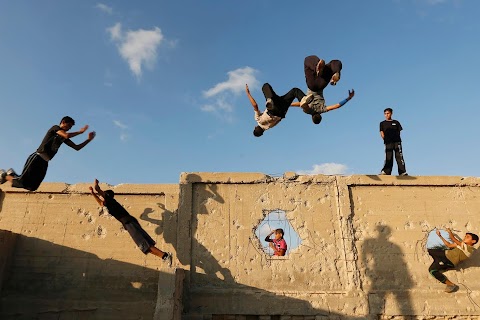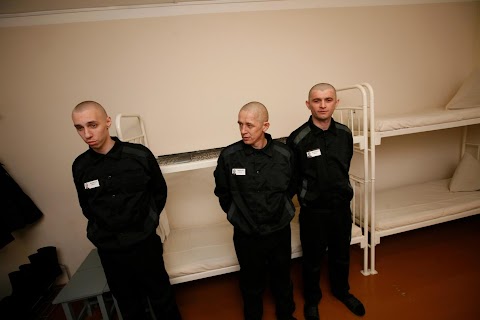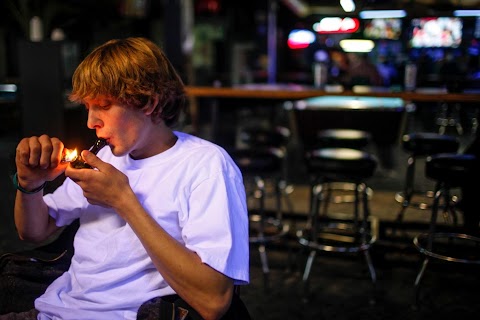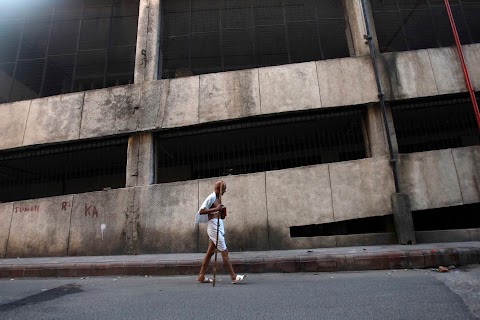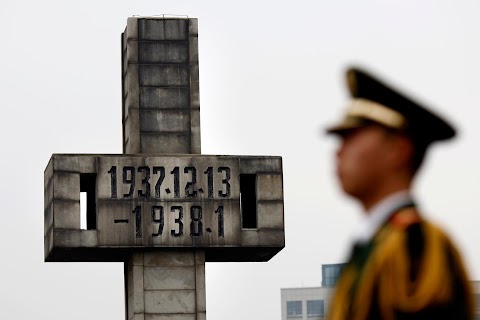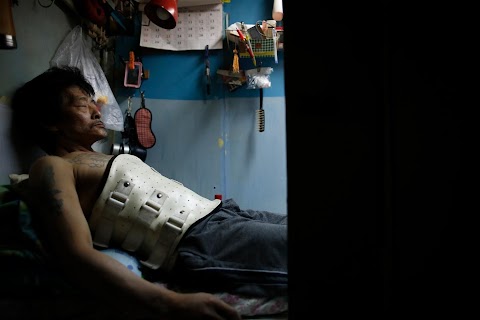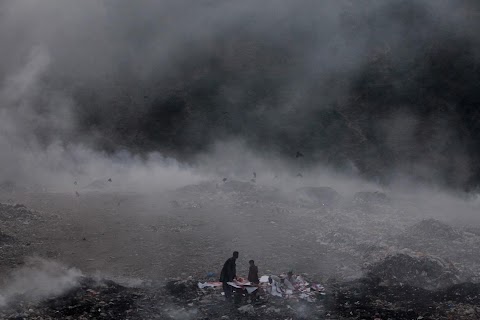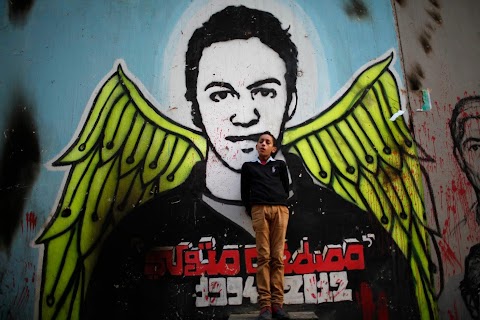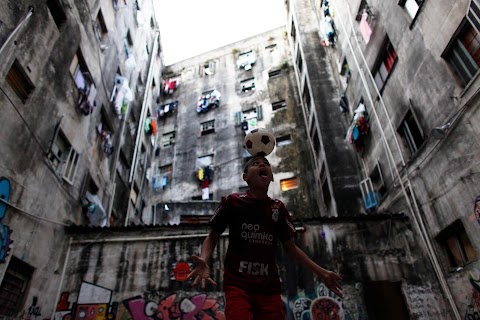
Finding a real roof
 Nacho Doce
Nacho Doce
An estimated 400,000 people in Sao Paulo are in need of proper, stable housing. Among them are 4,000 families who have taken the matter into their own hands.
These families are members of Brazil’s Roofless Movement, a group that forces its way into vacant buildings - like the one where this boy plays with a football - and lives in them as squatters, taking advantage of a law that makes it difficult for them to be evicted.
Slideshow

Members of the Roofless Movement or "Movimento dos Sem-Teto", sit on couches in an empty building - one of 11 empty properties that the meticulously organised movement took over in Sao Paulo in a single night.

A transsexual member of the Roofless Movement cleans a shared bathroom in one of the 11 empty properties that the group took over the night before. In total, 1,200 families carried out the occupation of the buildings, which were all in a 12-block radius.

A member of the movement puts up a wooden board in a recently occupied building to give himself some privacy in his new home. The majority of the Roofless Movement’s members don’t start squatting in abandoned buildings because they are homeless, but because their previous housing - mostly in the city’s sprawling favelas - is unstable and inadequate.

The child of one of the movement's members plays in a pool of water in one of the 11 recently occupied, empty buildings. Once families are inside the vacant properties, a lengthy legal process is necessary to evict them, so generally they can stay there for some time.

Two young members of the movement stand in the corridor of one of the 11 buildings, which are all in the centre of the city.

A family sleeps on the floor of a vacant apartment in one of the occupied buildings in central Sao Paulo. Many members of the Roofless Movement have jobs in the centre of the city, but cannot afford to pay for housing there.

A woman belonging to the movement does laundry in one of the occupied buildings. The movement’s leaders organise life inside these properties with rigid discipline: arranging a cleaning rota, controlling who comes in and out, and designating shared spaces and offices among the apartments.

A member of the Roofless Movement leaves to go to work in the morning through a hole made with a sledgehammer in one of the 11 empty buildings. The movement broke into the properties with the help of members who smashed their way through with hammers and crowbars.

Members of the movement collect donations of fruit from the municipal market to take to some of the 11 occupied buildings. These donations are one of the schemes organised by the Roofless Movement's leaders.

Members of the movement wait before the operation to occupy the 11 empty buildings. The movement's leaders registered the names of those present to keep tabs on the families moving in.

Members of the movement’s specially organised “Front Line” team break into one of the buildings using crowbars and sledgehammers, and are not deterred by a security guard trying to stop them from the other side of the door.

As one of the buildings is broken into, families who are moving in march towards it with their belongings.

Members of the Roofless Movement who took part in the operation to occupy one of the 11 buildings the night before wash the floor of their new home.

One of the squatters saws up sheets of plywood to make a studio inside one of the occupied buildings. Many members of the movement embellish their new homes by adding improvised wooden walls.

They make the spaces more home-like with mattresses, cooking equipment and other belongings.

A member of the movement watches TV inside one of the occupied buildings.

Members of the movement look out from the balcony of one of the buildings they have taken over.
"The door finally gave way, just as the police were getting out of their cars."
It was almost midnight on Sunday night. This was the hour when 1,200 families planned to occupy 11 vacant buildings in downtown Sao Paulo. They wanted to improve their own living conditions by squatting in the buildings for long enough to make their eviction a long, drawn-out legal process. In the meantime they would be able to go on living their daily lives.
I arrived at the meeting place for one of these occupations, and found around 150 families sitting along a wall with their suitcases. The leaders were registering the names of all present in order to keep control over who would enter the empty building. In other locations around the city, there were ten more groups like this one. They were all ready to act.
These well-organised groups were part of the Movimento dos Sem-Teto, or Roofless Movement. The movement’s members are people who live in precarious housing in high-risk areas in Sao Paulo, mostly in the slums known as favelas. Contrary to what the group’s name implies, the heads of most of the families in the movement have jobs, and most are not homeless. Rather, they are in need of stable, dignified housing.
The Roofless Movement almost always takes over buildings in the city centre where many of its members work, and where they can’t afford to live in decent housing. The lack of a more extensive subway system in Sao Paulo, which has more than seven million private cars, also makes it difficult to live on the outskirts and work in the centre of the city.
With an hour to go before the occupation started, a woman appeared with a serious look on her face. Her name was Netti and she was the organiser of the Roofless occupations.
She began talking to different people, and she told me to stick to Manuelzinho, the leader of the Front Line team - the group that carries sledgehammers and crowbars to break down the front doors of vacant buildings. Among them are also other men whose job it is to fend off any police who might arrive before they are all inside the building.
With just 30 minutes to go before the planned occupation, the leader of the Front Line team briefed the group on how to proceed. I heard the call, “Onward to battle,” and they all marched off in a line. I knew I had to stay in the middle of the group so I wouldn’t miss anything.
As we marched to the waiting van, we passed the families who all stared at us. Some had done this before, but others were beginners. We climbed into the van lashed by heavy rain, and in just a few minutes we were at our destination.
We were on the street in a flash, and everyone knew exactly what to do. The crowbar was in place and the sledgehammer began to do its work. Just then, a security guard appeared on the inside of the door, and tried to stop the occupiers, but the Roofless activists were entirely concentrated on their mission, and on their need to succeed. The door didn’t give way easily, and we could hear police sirens.
Then Manuelzinho took hold of the sledgehammer. Under the weight of all his strength, adrenaline and experience, the door finally gave way, just as the police were getting out of their cars.
As they had rehearsed, a group of men blocked the police’s entry to the door and with some of the families already inside, others appeared from around the corner with their suitcases heading in a straight line towards the door. Once inside, the families and activists knew that the police couldn’t enter without a court order. That was their strategy.
The rain no longer bothered anyone, although I constantly had to dry my lens with my shirt. I entered the building, climbed the stairs, and squeezed through a partially open window to stand on a balcony.
Below, on the street, was the leader Netti, calling out from the street with her arms outstretched, looking upward. “Now you have a place to live!”
